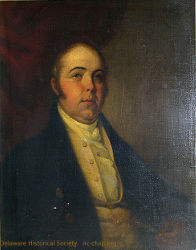John Lewden Jr. (1739-1809)
 Click on image to enlarge or for higher resolution |
Title/Occupation | Varied businesses |
|---|---|---|
| Address | 107 East Main Street, Christiana | |
| Artist | ||
| Date painted | 1800-1820 | |
| Credit | Delaware Historical Society | |
| Married | ||
| Parents | ||
| Children | ||
| Link | ||
From Economic History in the Philadelphia Region: DHS owns a variety of documents relating to the varied business operations of the Lewden family of New Castle Hundred in Lewden Family Papers (2 folders). The senior member of the family, John Lewden (d. 1744) left his sons John, Jr. and Josiah a tract of land in New Castle upon his death. Josiah formed a commercial partnership with Robert Duhamel, "Lewden & Duhamel." From the West Indies Lewden shipped coffee, sugar, and cocoa to his contacts in Philadelphia and Delaware, Meanwhile, he also secured cargoes of manufactured goods for Port-au-Prince and St. Sebastian. Jeremiah's letters comment on the Santo Domingan slave revolt of 1790 and prospects for trade, his observations of Toussaint and the burning city. The collection includes letters from Josiah Lewden to his father, David Hines, and others, as well as receipts and invoices. Lewden and Duhamel, Ledger of trade to Santa Domingo, 1801(1 vol.) provides a detailed record of Josiah Lewden and his partners' activities at Santo Domingo, including voyages to Philadelphia, Wilmington, and Europe. In contains accounts with individuals (some in French), firms, and captains. Coffee, sugar, and "yellow soap" are listed most often, and the ledger has a detailed list of coffee duties paid. John Jr, seems to have operated a farm on the Hundred, but he was also involved in some aspects of his brother's trade. John Jr.'s son, Jeremiah (d. 1840) owned a tanyard in New Castle. The Society owns four volumes relating to Jeremiah's business operations. Jeremiah Lewden, Ledger "E" contains a list of expenditures, tannery accounts with various individuals, and places of residence and occupation for some entries. Most payments are in cash. The ledger also shows that Jeremiah was an early investor in the Christiana Canal Company. A Receipt Book (1815-1841) refers to purchases of bark and lime for the tannery, foodstuffs, and services such as woodcutting and carding wool. A Daybook, (1809-1810, 1811-1812) consists of a mixture of daily business and personal accounts for Jeremiah's house, farm, and tannery. This volume details prices and types of leather used in tanning. The date painted (1830) may be questionable given the birth date (1813) of the artist. | ||
In the top one percent of assets in the 1776 tax records. for New Castle Hundred. | ||
Jim Meek
nc-chap.org 2014, 2015
nc-chap.org 2014, 2015